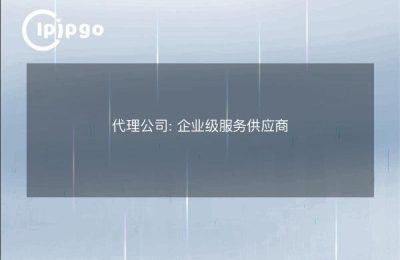
The need for proxy IPs: adding a cloak of invisibility to crawlers
Crawler, the back of the Internet, as if a silent traveler, quietly walk through the site of each data path, quickly and efficiently collect information. But as we all know, although crawlers are efficient, they are also easily exposed to bright ipipgo. Especially when the same website request from the same IP address, they are like a move to attract attention, immediately recognized by the server, and is regarded as a "red flag". Thus, the proxy IP this "cloak of invisibility" was born. It brings greater flexibility and stealth for the crawler, and has become an indispensable asset in the work of the crawler.
Just as a magical cloak does not ensure 100% invisibility, the proxy IP is valid, how to verify the proxy's ability to "invisible" is the question in the mind of every crawler developer. Today we will talk about how to test the validity of the proxy IP, to ensure that the crawler on the Internet unimpeded.
Step 1: The most direct validity verification - request testing
Before it all begins, we need to understand the most straightforward method - sending a request to test. It's like using a magnifying glass to see if the proxy IP actually works silently.
Choose a simple public API interface, like the one returned by the HTTP request header. Then, send a GET request using the proxy IP and see what the status code is in response. Normally, if the proxy IP is valid, you should get a status code of 200, indicating that everything is fine; if the returned status code is 403, 404, or some other error code, it means that the proxy IP may have been blocked, or the request simply didn't make it to the target server.
Of course, this is just a basic test, simple and crude, yet directly effective. Think of it like a mirror of your first day in your new clothes, simple and straightforward.
Step 2: Does it meet the geographical requirements?
Sometimes, our proxy IP is not only to hide our identity, but also for the purpose of meeting some specific geographical requirements. For example, you may need to grab data from a website in a specific country or region, at this time the proxy IP is like a time-traveling ticket, taking you from one place to another place quickly shuttled.
This method of verification is relatively more detailed, and you can verify that the proxy IP meets the requirements by looking at its geographic location. Here are some IP location tools that can help you do this, such as GeoIP or ipinfo.io. With these tools, you can check if the proxy IP is indeed from the geographic location you need, and avoid wasting time in the wrong location. For example, if you obviously want to crawl data from Tokyo and you end up using a proxy IP from the US, that would be a tragedy.
Step 3: Speed and Stability Testing
Whether the proxy IP is effective or not, in addition to whether it can be accessed normally, you also need to look at its stability and response speed. After all, if the crawler is always frequently interrupted because of the instability of the proxy IP, the task will not be completed successfully, just like you are driving on the highway, and suddenly encountered a road that constantly has flat tires, the experience is certainly not wonderful.
Testing the stability of a proxy IP can be accomplished by testing requests over a long period of time. For example, set up a timed task to send requests to the target server at regular intervals to see how the proxy IP performs at different times. If a certain proxy IP drops out frequently, or the response time is unstable, then you need to change the proxy.
In order to make the test results more scientific, you can also use some speed test tools, such as Ping test. With Ping test, you can visualize the latency of the proxy IP, and then determine whether it is suitable for long time stable operation.
Step 4: Detect if the proxy is blocked
Even if the proxy IP can work properly for the time being, you can't rest on your laurels. Like a person wearing an invisibility cloak, it may escape pursuit for a while, but if it accidentally leaves traces, it may still be found. Crawlers using proxy IP, the same need to worry about proxy IP is the target site blocking.
In order to verify whether the proxy IP is blocked, you can test it by sending a large number of concurrent requests. You can send multiple requests at the same time to simulate the real working scenario of a crawler. If all the requests return normally, it means that the proxy IP is not blocked; if some requests return error messages such as 404 or 403, it means that these proxy IPs have been recognized and blocked by the target website.
Step 5: Switching and Rotation Strategies
A single proxy IP can be easily detected, so crawlers often use proxy pools to ensure that their tasks are accomplished successfully. Proxy pools are like a huge arsenal, constantly providing new proxy IPs for the crawlers to avoid being blocked by overusing a certain IP.
You can improve the effectiveness of proxy IPs by using proxy pool rotation strategies, such as setting the maximum number of times an IP can be used, or automatically switching different proxy IPs based on time intervals. For example, set the maximum number of times an IP can be used, or automatically switch to different proxy IPs based on time intervals. in this way, you can reduce the risk of exposure of individual IPs, and ensure that the crawler is constantly "changing identities" during execution, so that the target website has no way of noticing.
Summarizing: Staying alert and flexible
Through these methods, we can effectively verify the validity of the proxy IP to ensure that the crawler task is carried out smoothly. However, it should be noted that the network environment is changing rapidly, the site will also continue to strengthen the protection measures for crawlers. Therefore, even with the proxy IP, we still need to remain vigilant and flexible to deal with various emergencies.
Proxy IP is like a layer of umbrella to protect our crawlers from the wind and rain, but only constant testing and adjustment can make this umbrella always strong and not fall. We hope that through these effective verification methods, you can better understand the operation of the proxy IP, improve the efficiency of the crawler, and successfully obtain the information you want!








